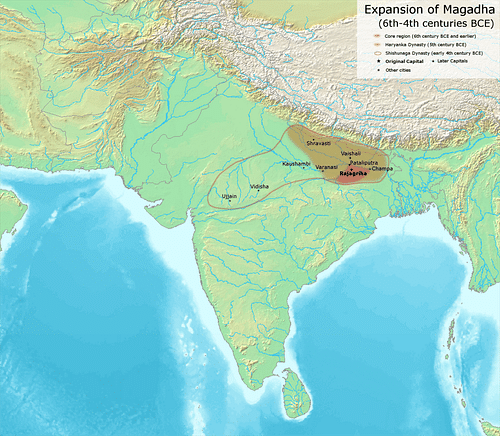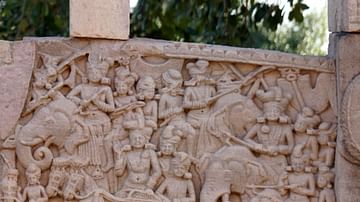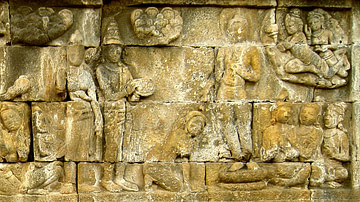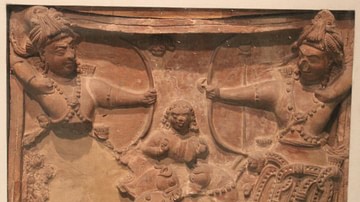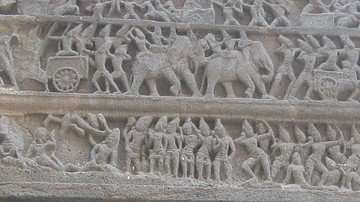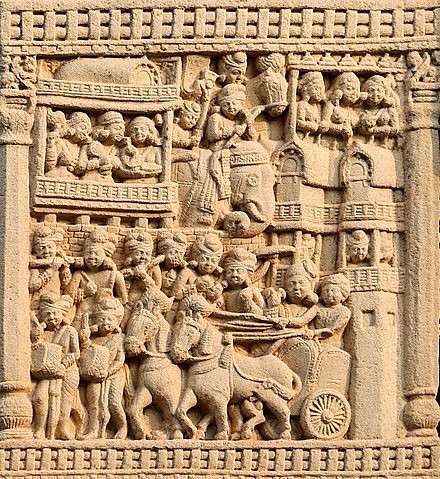
Ajatashatru (c. 493/492 BCE - c. 462/460 BCE) was the second important king of the Haryanka Dynasty, who came to the throne of Magadha by deposing and executing his own father Bimbisara. The Haryanka Dynasty (c. 545/544 BCE - c. 413 BCE) came into prominence during the rule of Bimbisara (r. 545/544 BCE - 493/492 BCE), who extended the kingdom through conquests and marriage alliances. It was the first important Magadhan Dynasty whose historicity can be ascertained with verifiable facts. Before them, a mythical dynasty by the name of Brihadratha is often talked about but does not have any archaeological or contemporary literary evidence to back up its claim. The Magadha Kingdom started its expansion from the time of Bimbisara, but Ajatashatru annexed several important and powerful kingdoms in its vicinity – Kosala and Kashi, and then Vrijji and his empire roughly covered the present-day Indian states of Bihar, Jharkhand, Uttar Pradesh (some minor parts), West Bengal (some major parts), Odisha (some parts) and also some parts of the neighbour countries of Bangladesh and Nepal.
Early Life & Ascension
Bimbisara ruled from a place called Girivraja, which was also known as Rajagriha and is identified with modern Rajgir now. He made three important marriage alliances during his time, out of which Princess Chellana of the Licchavi clan of the Vrijji confederation and daughter of King Chetaka was the mother of Ajatashatru. Ajatashatru, also known as Kunika, grew up in Rajagriha under the able guidance of his father. He was trained in ancient Indian warfare, archery, fencing, horse riding, knowledge of the scriptures and many other disciplines in accordance with the Indian tradition of princely education. There are various legends associated with the birth of Ajatashatru in both the Jain and Buddhist literature. His name in the local language means 'one whose enemy has never been born and hence he is already victorious' and it is said that Ajatashatru's mother had bad dreams and negative premonitions during her pregnancy which indicated that the child born would be evil and harmful to his parents. However, there are no historical records to corroborate this story. It is probably a later addition, a common Indian tradition of attaching supernatural elements to a well-known historical figure.
When Ajatashatru grew up, he was taken to the war against Anga by Bimbisara. The Anga Kingdom (present-day West Bengal, Bangladesh, and Odisha) was Magadha's immediate neighbour, with their capital at Champa. It had access to trade routes and coastal areas for overseas commerce. Bimbisara understood its importance; he attacked and defeated the Anga forces in battle. After the battle was won, Ajatashatru was installed as a governor. Anga soon proved to be the most flourishing region for the Empire as its overseas trade made the kingdom rich and its army powerful. Bimbisara had always considered Ajatashatru to be his ideal heir and hence he had put him there in charge of the most important and prosperous province. However, Ajatashatru's ambition soon got the better of him and he was not satisfied just with the control of one region.
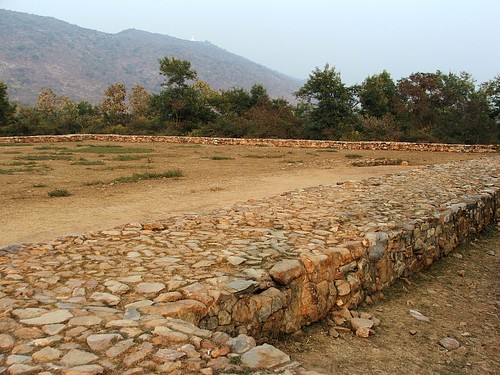
According to Buddhist sources, Ajatashatru was continuously ill-advised by a monk called Devadatta, a cousin of Gautama Buddha. Bimbisara by then had probably turned a follower of Buddhism and Gautama Buddha's growing influence on him made Devadatta jealous. He coveted a position for himself in the imperial court and convinced Ajatashatru to usurp the throne through a coup. Ajatashatru was tricked by all these and he soon deposed and later executed his own father after imprisoning him. Though, a legend also says that Bimbisara took his own life after he was being imprisoned. Whatever the case, Ajatashatru was responsible for his father's death which gave him a chance to ascend to the throne of Magadha.
Conquests
Ajatashatru's cruelty brought him to the throne, but his ambitions did not end there. He wanted a greater kingdom for himself. In the meantime, shocked at the patricide committed by Bimbisara's own son, one of his wives, the princess from the Kingdom of Kosala died too out of grief or followed her husband by committing suicide. She was the sister of King Prasanajita, the ruler of the Kingdom of Kosala who had gifted the flourishing city of Kashi to Bimbisara as dowry. After losing both his sister and brother-in-law, an ally, Prasanajita was enraged and took Kashi back. This gave Ajatashatru a reason to attack Kosala, which roughly corresponds to some part of the modern-day Uttar Pradesh state of India.
The battle between Ajatashatru and Prasanajita witnessed a see-saw of fortunes for both. Once, when Ajatashatru was defeated and caught without guard, his life was spared by the older Prasanajita who soon forgave him and also returned the city of Kashi to him. However, Prasanajita was soon deposed by his own son and Ajatashatru returned to attack the Kingdom of Kosala with his full might. Now that the kind Prasanajita was gone, he soon annexed Kosala with all its resources.
Emboldened by this conquest and also replenished by the continuous supply of armaments from the rich deposits of iron ores in his kingdom and elephants and woods from the nearby jungles, Ajatashatru next turned his attention to the powerful confederation of the Vrijjis and their capital at Vaishali. Ajatashatru's mother belonged to the Licchavi clan of the Vrijji confederation, but this did not stop him from attacking this kingdom. His ambition was insatiable.
At that time, the Vrijji Kingdom (areas of Northern Bihar of present-day India) was an entity ruled by a confederation of the important clans of the town with the clan heads at the helm. The Vrijjis were united and they possessed a mighty and powerful army. Despite his military might and unlimited supplies, Ajatashatru could not overpower the Vrijji confederation after several attempts and so he turned to guile. He understood that while united the Vrijjis could never be defeated and looked for ways to break that unity. Soon, he devised a plan and planted one of his most trusted ministers probably by the name of 'Vassakara' amidst them, probably in disguise or as somebody who wanted to defect. After gaining their trust and settling down there, Vassakara slowly and gradually manipulated his way and planted the seed of dissension amongst the Vrijjis. Their unity was gradually broken after the wily minister continuously ill-fed one against another with false stories.
When they started squabbling amongst themselves, Ajatashatru attacked the city of Vaishali with all his might. He also improvised the technique of his attack this time by introducing two new and unique war machines. One was a catapult, which could throw huge stones from its arms amongst the enemy ranks, and another a chariot-like machine with huge maces or swords attached to it, which could cut and mow down the enemy while moving. After a bloody struggle, Ajatashatru defeated the combined forces of the Vrijjis which they could muster at the last moment. He annexed the kingdom and added it to his already growing empire. During this time, a legend appears about a famous courtesan of Vaishali called Amrapali who dated Ajatashatru and later became a disciple of Gautama Buddha. This cannot be corroborated by historical evidence now, but this legend has grown and captured the popular imagination of contemporary times.
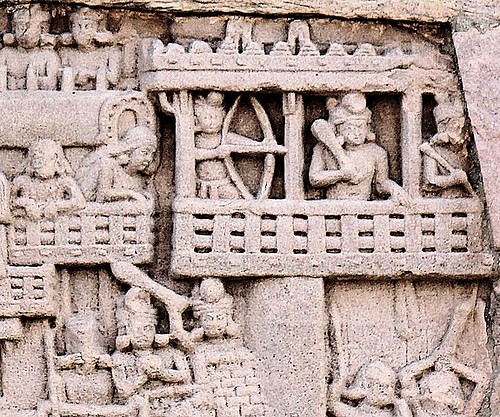
The battle with the Vrijjis took a long time to settle, and it is said that Ajatashatru fought with them for 16 long years (from c. 484 BCE to c. 468 BCE). Besides further conquest, Ajatashatru attacked this kingdom for two other reasons. He was angry at the Licchavis for not agreeing to share the contents of a jewel mine which was situated at both the kingdoms' border and which the Licchavis had earlier promised. Secondly, two step-brothers of Ajatashatru had taken shelter at Vaishali after deeply offending him by running away with some of his precious possessions.
Buoyed by this success, Ajatashatru then turned his attention to the most powerful kingdom of that time in the Indian subcontinent – Avanti with its capital at Ujjain (modern-day Central Indian state of Madhya Pradesh and some other parts of the neighbour states). The engagement reached a stalemate after some time and the Pradyota Dynasty of Avanti would only finally succumb to the Magadhan Empire under the following Shishunaga Dynasty.
Administration
Ajatashatru ruled from his capital of Rajagriha, just like his father Bimbisara, but during the long Licchavi campaign, for additional safety, he also constructed a fortified city near the Ganges River at a place called Pataligrama, which became the later Magadhan capital of Pataliputra. It has now been turned into the modern city of Patna. Rajagriha for its part was also fortified by five towering hills on all its sides, and Ajatashatru made it unbreachable by filling the gaps in the hills with stone walls. He inherited the administrative system set up by his father and the army with its four divisions of chariots, infantry, cavalry, and elephants. They also maintained some navy forces after the Anga conquest.
Religion
Both the Jain and Buddhist sources claim that Ajatashatru followed their paths. Ajatashatru visited Gautama Buddha when he realised his mistake of executing his own father. He also supported the followers of all other religions who came to his kingdom of Magadha at that time. In religious tolerance, Ajatashatru seemed to have followed his father Bimbisara who supported various religions by lowering or withdrawing taxes for ascetics. Due to the rise of Buddhism and Jainism in Magadha under Ajatashatru, the Brahmanical religion seemed to have taken a backseat there and so the Brahmans looked down upon Magadha as evident in literature.
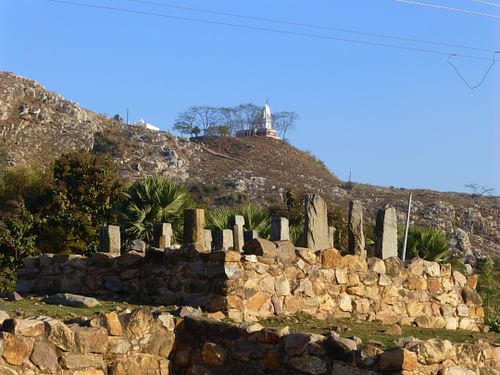
Death & Legacy
Ajatashatru was succeeded by his son Udaya or Udayin who supposedly deposed and executed his own father, thus following a tradition started by Ajatashatru himself. The following rulers of the Haryanka Dynasty after Udaya too committed patricide one by one, and soon the last Haryanka ruler was deposed by the people and replaced by the Shishunaga Dynasty. Ajatashatru's era remained very important in the context of Indian history not just for its empire-building but, with people like Gautama Buddha and Mahavira Vardhamana living at the same time along with numerous other ascetics with their different philosophies, it also saw a spirit of asceticism and enquiry into the broader mysteries of the world.
